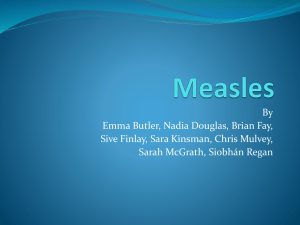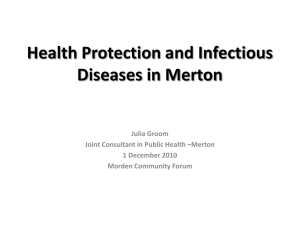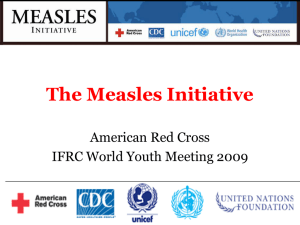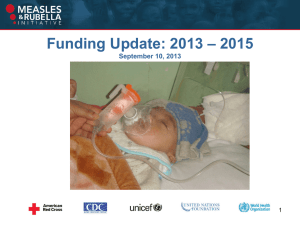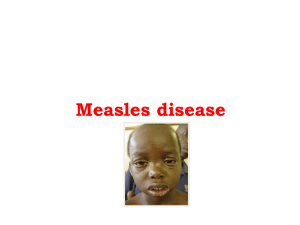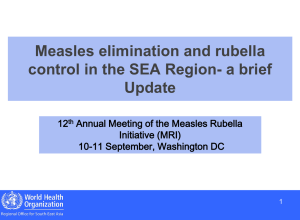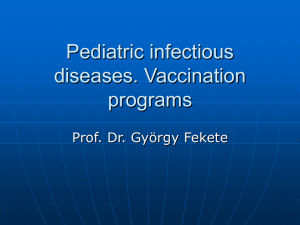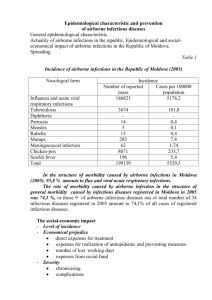Inverse method - University of Alberta
advertisement
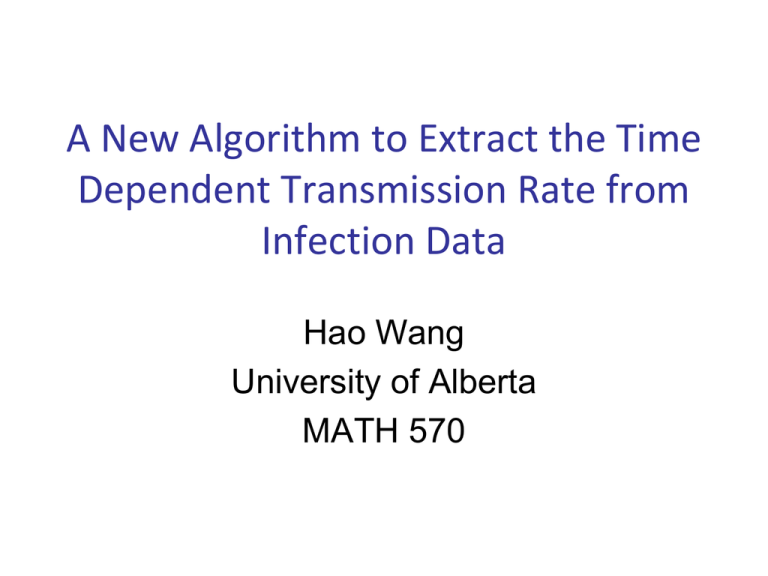
A New Algorithm to Extract the Time Dependent Transmission Rate from Infection Data Hao Wang University of Alberta MATH 570 from model Infection data smooth interpolation Birth data Algorithm (t ) FT to check dominant frequencies Outline of talk 1. Very brief sales pitch for utility of mathematical models of transmission of IDs in populations 2. Seasonality/periodicity of IDs 3. The time-dependent transmission rate (coefficient) of an ID, and a new method to estimate it from infection data. 4. Application to Measles - detection of 1/yr cycle and 3/yr cycle Introduction • Molecular studies have revolutionized our understanding of the causes and mechanisms of IDs. • However, the quantitative dynamics of pathogen transmission is less understood. • Large scale transmission experiments (e.g., influenza transmission in ferrets) are useful to understand the transmission dynamics, but are usually impractical (economic and ethical reasons). Mathematical models • Thus we need indirect methods to study the transmission dynamics of an ID in a population. • Mathematical models are a powerful tool. • Mathematical models can include virology, immunology, viral and host genetics, and behavior sciences. • Main way to estimate key epidemiological parameters from data. Seasonal dependence of occurrence of acute IDs • Many IDs exhibit seasonal cycles of infection (Is this true for animal IDs?) • Influenza, pneumococcus, rotavirus, etc. peak in Winter • RSV, measles, distemper (some animal IDs), etc. peak in Spring • Polio peaks in Summer Weekly measles cases in seven UK cities: 1948-58 Why ??? Changes in atmospheric conditions ? 1. Cholera outbreaks follow monsoons in south Asia. 2. Lower absolute humidity in Winter causes expelled virus particles to persist in the air for long periods. (Shaman and Kohn, PNAS, 2008) Why ??? Prevalence of pathogen ? Virulence of pathogen ? Behavior of host ? (e.g., kids have no school during summer and Christmas, and have fewer contacts) Mechanism assumed by most measles modelers (evidence?) Seasonal dependence in host susceptibility? (Scott F. Dowell, Emerging Infectious Diseases, 2001) Our goal: understand the seasonal dependence through studying the time-dependent transmission rate. Transmission rate of an ID • An effective contact is any kind of contact between two individuals such that, if one individual is infectious and the other susceptible, then the first individual infects the second. • The transmission rate of an ID in a given population is the # of effective contacts per unit time. • The transmission rate is the rate at which susceptibles become infected. How to estimate transmission rate from infection data? • Almost all authors use an SIR-type mathematical model. • SIR models assume homogeneous or mass-action mixing of infectives and susceptibles. • If the number of susceptibles/infectives doubles, so does the number of new infectives. Basic SIR transmission model ν Basic SIR transmission model Infectives recover (with permanent immunity) at rate ν. Thus the duration of infection is 1/ν. In their textbook “Infectious Diseases of Humans”, Anderson and May stated: ”... the direct measurement of the transmission coefficient is essentially impossible for most infections. But if we wish to predict the changes wrought by public health programmes, we need to know the transmission coefficient.'' Time dependent transmission coefficient For many acute IDs, the transmission coefficient is time dependent. We will consider (t). SIR model with time dependent transmission rate Inverse problem Given smooth f(t) > 0 defined on [0, T], and > 0, does there exist (t) > 0 in SIR model such that I(t) = f(t) for 0 ≤ t ≤ T? We prove YES, with mild necessary and sufficient condition Mark Pollicott, Hao Wang, and Howie Weiss. Extracting the time-dependent transmission rate from infection data via solution of an inverse ODE problem, Journal of Biological Dynamics, Vol. 6: 509-523 (2012) This result clearly shows a serious danger in overfitting transmission models Explicit Inversion formula Works provided denominators 0 Underdetermined inverse problem Inversion requires that and There are infinitely many solutions. Instead of the actual necessary&sufficient condition is f ' (t) νf(t) 0 because of equation (2) (for I) But infection data is discrete First apply your favorite smooth interpolation method (spline, trig, rational, etc. ) to smooth the data and then apply the inversion formula Interpolation Two artificial examples Robustness Simulations show that the recovery algorithm with any reasonable interpolation method is robust with respect to white noise up to 10% of the data mean, as well as the number and spacing of sample points. Derivation We require I(t)=f(t) Solve (2) for S(t) and plug into (1) Derivation, continued Bernoulli equation - has closed form solution Bernoulli equation The change of coordinates x = 1/ transforms this nonlinear ODE into a linear ODE Solution Application to Measles • Respiratory system disease caused by paramyxovirus. • Spread through respiration. • Highly contagious. • R0 = 12-18 • Virus causes Immuno-suppression • Characteristic measles rash • Infectivity from 2-4 days prior, until 2-5 days following onset the rash • average incubation period of 14 days Measles mortality • Mortality from measles for otherwise healthy children in developed countries 0.3%. • In developing countries with high rates of malnutrition and poor healthcare, mortality has been as high as 28% • According to WHO, in 2007 there were 197,000 measles deaths worldwide. Weakly measles cases in seven UK cities: 1948-58 Aggregated UK measles data Notice pronounced biennial and annual spectral peaks What is driving the biennial cycle? Modeling pre-vaccination measles transmission SEIR model with vital rates Measles (t) from transmission modeling literature All measles modelers assume that (t) is solely determined by school mixing, and choose (t) to be pure sine function or Haar function with one year period. Extended recovery algorithm Parameterizing the measles transmission model We chose parameters for measles from Anderson & May: =52/year =52/12/month, a=52/year=52/12/month, =1/70/year=1/70/12/month, where 1/ is the period of infectiousness, 1/a is the latent period, is the birth rate. (0) from measles modeling literature Recovered (t) with constant birth Extended recovery algorithm with historical birth rates All other steps in the algorithm remain the same except in Step 4: UK births from 1948-57 Recovered (t) with actual births (t ) (0) 140 With corrected data To test the robustness of our spectral peaks, we incorporate the standard correction factor of 92.3% to account for the underreporting bias in the UK measles data (with estimated mean reporting rate 52%, note that 92.3% is computed from 1/0.52 − 1). (t ) (0) 60 Recall, all measles transmission models assume (t) is solely determined by school mixing, and choose (t) to be pure sine function or Haar function with one year period. The period 1/3 year seems related to internal events (three big holidays in UK) within each year. Comparison with Haar (t) Summer Low points are consistent. Earn et al., Science, 2000 Cities test (constant B.R.) Final Comments and Open Problems • Study statistical properties of the estimator for (t) • The idea can be applied to almost any ID transmission model (waning immunity, indirect transmission mode, more classified groups, etc.) • Apply to other data sets • Stochastic version of the algorithm • Examine why different UK cities have quite different dominant frequencies Key references 1. Bailey (1975) 2. Deitz (1976) 3. Schwartz and Smith (1983) 4. Anderson and May (1992) 5. Bolker and Grenfell (1993) 6. Keeling and Grenfell (1997) 7. Rohani, et al. (1999) 8. Earn et al. (2000) 9. Keeling et al. (2001) 10. Finkenstadt and Grenfell (2002) 11. Bauch and Earn (2003) 12. Dushoff, et al.(2004) Coauthors Howie Weiss Mark Pollicott (Georgia Tech, US) (Warwick, UK)

